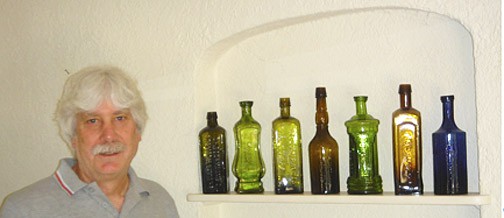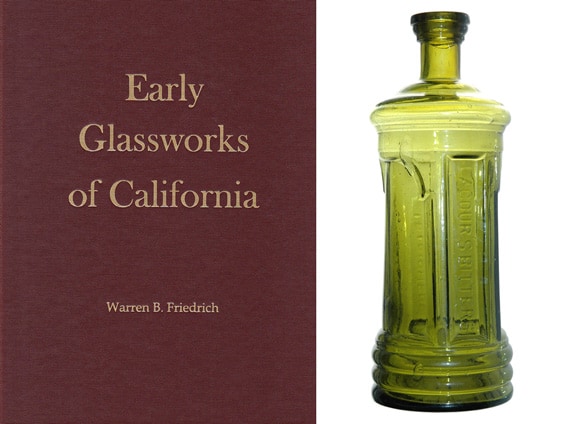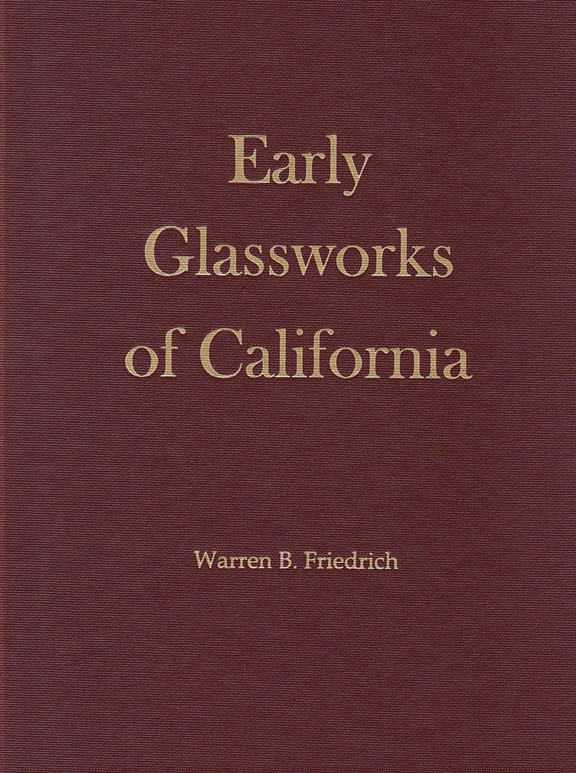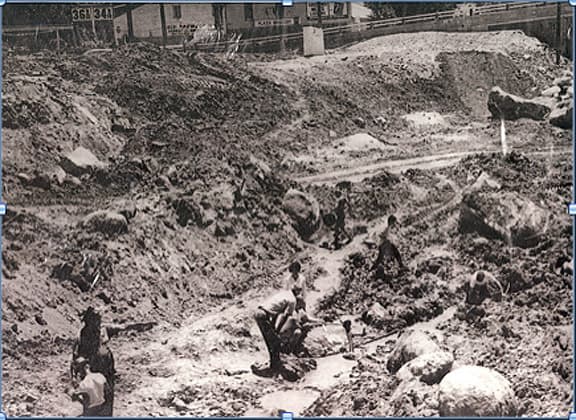[In from Pam Selenak]
It gives me great pleasure to announce that Warren Friedrich will be our guest speaker for the banquet at the FOHBC Reno Expo and will also be one of the two (2) 2012 FOHBC Hall of Fame inductees (see nomination below) at the event. We hope to see you for some good food, great company as well as an informative presentation on a brief history of the early glassworks of California from the first commercial bottle factory in 1859 to the demise of the largest factory in 1899.
Pam Selenak | FOHBC Public Relations Director
THE FEDERATION OF HISTORICAL BOTTLE COLLECTORS (FOHBC)
2012 HALL OF FAME Nomination – Warren Brock Friedrich
The Genesis of a Bottle Collector
It was with an unlikely beginning that Warren Friedrich started down the road toward bottle collecting. He was born in southern California in the autumn of 1954, the son of a World War II barn-stormer and his University of Southern California educated wife, who, together, flew crop-dusters over the salad bowl of California.
Seeking a better environment to raise their only child, they set their sights on Nevada City, a tiny rural community in the foothills of the Sierra Nevada Mountains and put down roots. And, this move would make all the difference in forming Warren into the history enthusiast he is today.
While his father immersed himself in establishing a tax preparation business with a commercial fishing enterprise after the tax season, his mother pressed into local politics, becoming the first woman to be elected to the town’s city council. Left to his own devises, Warren soon found that this quaint little town had much to offer in the way of treasure hunting. This lanky, long-legged boy began spending his days miles from home, often up to his waist in a midden dump, digging up shards of glass, miners’ tools and crucibles, and Indian beads. His boyhood bedroom soon resembled a Gold Rush curio shop.
Looking at this sleepy little tourist town today might fool you into passing right through. But, in the mid-1800s, Nevada City was the third largest city in California. The 7 hills surrounding the mining camp town rang with the clang of pick axes and shovels and cries of miners as they dug and sluiced and panned and blasted the hillsides with hydraulic monitors in search of gold. And a city grew around them, complete with 2 soda bottling works, saloons, brothels, churches, and a large Chinese population brought in to build roads through the steep mountains. And when the boom was over, they left behind their trash.
While his friends were spending hot summer afternoons in the cool darkness of the local movie theater, Warren was picking his way through dark tunnels of long-abandoned mines. Sometimes he managed to enlist friends to join him in his treasure hunts and one of those times was captured in a photograph taken when he was only 10 years old. Progress had come to the foothills and a freeway was being built right through Nevada City. Old buildings were demolished and historical sites fell to Progress as state workers pushed the road through the hills. In the wake of this upheaval, the town’s history began appearing as privies and trash dumps emerged from the wreckage. This 1965 photo shows a scrawny boy, gazing with intense concentration at the lucky find in his hand, while standing in the middle of what is now a 4-lane freeway. After the work crews left for the day, Warren and his friends would scramble through the day’s tractor work, finding bottles and jars and myriad miners’ junk which had been tossed with the trash. It was glorious pickings for a young bottle hound. While still in high school his interest was evident to his teachers and he was asked several times by the history teacher to bring his collection and talk to fellow students about local history. Even as a boy, Warren was garnering new enthusiasts to the collecting world.
As Warren grew up, his childhood hobby had to compete with a growing interest in cars and girls, and the inevitable reality of life, work. And, his boyhood collection sat dusty for a while as he moved to Sacramento to attend college. However, while pondering a major, his love of history lured him back and he chose Recreation and Park Administration as a course of study. This allowed him to study early California architecture and its restoration and gave him an excuse to ramble the hills again. It also trained him to do the kind of research he would need later in life when he embraced collecting in a more serious way. He received a Bachelor of Science degree in Recreation and Park Administration from the California State University, Sacramento, in 1976, with hopes of working in this field.
It wasn’t to be. He worked a number of jobs in various cities but city life was not satisfying so when his parents asked him to return to Nevada City to help with their growing business, he packed his bags and came home. For 17 years he helped his father both in the tax office in Nevada City and on their commercial fishing boat, the Carol B, named after Warren’s mother and based in Bodega Bay, California. After his father’s repose, Warren shouldered the business alone with the help of his wife, Linda, and together they worked hard to be able to retire with time to ramble through the hills together.
Collecting
During these years of hard work, Warren began collecting bottles in a more serious fashion. He amassed a modest collection of western bitters, focusing on condition and sheer numbers. It was during this time that he began traveling to shows and getting to know other collectors. In 1971, Warren joined the local bottle club, the Mother Lode Antique Bottle Club, and then the national club, then known as the Federation of Historical Bottle Collectors. In 1993 he co-founded the Downieville Antique Bottle Show, which remains today one of the best-attended shows by advanced collectors. He has been a contributing author as well as a co-author of bottle articles published in both Antique Bottles and Glass Collector magazine and the Federation-published Bottles and Extras magazine.
He has helped put on local shows and has had a keen interest in encouraging a younger generation to get active in the hobby. This continues to be a passion for him and he welcomes young diggers and collectors into his home and never begrudges a dinnertime phone call from them, sharing their enthusiasm as they excitedly ask questions about the history of some new find.
In terms of his own collecting, Warren found his interest being piqued by the fascinating shapes and tantalizing colors of bitters bottles. Enough so, that in 1994 he sold his entire bitters collection and began studying a specific group of early western bitters. It was the early California bitters which caught his eye. He was quite taken by the fanciful shapes and sometimes even more fanciful histories. It was a match made in heaven. His childhood treasure hunting in Gold Rush-era Nevada City, coupled with his educational degree involving early California history fueled the fire. He had found his niche.
Early Glassworks of California
Although the price tag on the first Lacour’s Bitters bottle he brought home made his wife’s knees buckle, she recovered and Warren pressed forward to learn more and bring more home. A passion to know the truth about the bottles is a consummate character of Warren’s. He is driven to know everything he can about a bottle and its manufacture. And, he is tireless in researching until he’s satisfied that there is no more to be learned. It was this keen desire to know about the bottles in his growing collection that led to the writing of his book, Early Glassworks of California, published in 2010, with revisions in 2011.
It’s important to understand his choice of focus for the book. While seeking information about his own bottles, Warren found that some bottle books, in an effort to help as many diverse collectors as possible, covered such a broad field that sometimes conjecture was offered as fact. Warren realized that you can’t be all things to all people and that he would have to narrow his focus to those bottles about which he could find primary source information. He strove to write only supportable information and include not only footnotes but scans of actual ads and articles. This allows the reader to see what he saw as he did his research from the comfort of their home. He doggedly edited the book, scouring out anything he felt was not supported by documents. Surprisingly, this doesn’t make for a boring read; actually, as one follows the men who came West and made their living building factories, hauling sand, concocting recipes, blowing bottles, going broke… and all on the wild Barberry Coast, you find yourself back in time.
So, Warren began his hunt in 2007 with the books on his own bookshelves, books written by pioneers in the hobby. He discovered that technology has enabled access to resources only dreamed of by these writers. While earlier writers often had to travel long distances to view library archives which might or might not hold information they were seeking, computer archives have made this research much more accessible. This is not to say that doing research today is a walk in the park! Warren drove from his home in Nevada City to numerous historical institutions day after day over the course of 3 years, pouring over microfiche, coming home with red eyes and exhausted from scouring page after page of tiny ads in 19th century newspapers caught on film. His goal was to produce the most definitive, comprehensive compilation of historical information on the glassworks and their products possible and to make it available to other collectors who were just as hungry for information as he had been.
The head librarian of the San Francisco Mechanics Institute, an esteemed continuously running archive of San Francisco history, took an especial interest in the research Warren was doing and did much to further it. Today, a copy of his book resides there, per her request.
Further research led him to the Society of California Pioneers in San Francisco, a prestigious society whose members include men and women who shaped and formed the fastest growing city on the west coast during the 19th century. During one visit the curator took Warren and his wife on a private tour, during which he was able to identify demijohns, still packed in their wicker and tule wrappings and stowed in wooden packing crates, to the delight of the curator. Early Glassworks was added to the Society’s collection, as well. Further requests for a copy of the book came from the California Historical Society in San Francisco as well as the California State Archives and the California State Library both in Sacramento. Additionally, Warren was contacted by a San Francisco book shop owner who deals with rare books and 6 copies were purchased for his clientele who are history scholars, not bottle collectors; the books were sold for 3 times the rate bottle collectors have paid and clearly show the broader appeal of the work.
As we all know, bottle and ephemera collectors are a generous lot and Warren is grateful for their sharing of time and information. In addition to historical libraries and societies, many collectors, authors themselves, including Eric McGuire, Tom Jacobs, Rick Simi, Bill Ham, Jeff Wichman, and Tim Higgins, to name a few, took time to share sources and leads. Richard Watson of New York graciously gave permission to publish pictures of rare glassmaking tools. Professional photographer, Kirk Amyx of Amyx Photography in San Francisco photographed some of the author’s collection for the book and the pictures in this book are stunning, offering a good look at bottles many people will never see in real life.
Once satisfied that he had found as much information as he could, more than 900 pages of historical material, he pared it down, editing many times, and, surprisingly finding new tidbits of information to include. The family joke became the newest pronouncement that the book was finally done.
The end result is a very tight book, narrowly focused to be as accurate as possible. It is a wealth of information about a brief era in history and the bottles produced as a result of it. Maybe not surprisingly, as the bottles from this era are a result of their geography so also the author is of his geography. And, the 2 are a good match for each other. One hopes that this book might just be the beginning of continuing research…
Beyond the Book
Like his pioneering predecessors, Warren knows that as more information is scanned and released, his work, like theirs, may be modified. He welcomes this because the truth is what matters. The more accurate information available to the collector, the better. And, perhaps beyond the contribution of the book itself, what Warren Friedrich brings to bottle collecting is the generous spirit in which it is offered, his tireless quest for facts, and the encouragement extended to a younger generation to take the plunge.










